
Education in the United States has endured its fair share of shifts in political tides, but if President Trump’s proposed budget cuts to the Department of Education are approved, they will sink the progress we’ve made to move from a strict academic testing model to one that recognizes the key to academic success is the support of the “whole child.”
We are in the beginning of a golden age of education with recent advancements in technology to support individualized learning, an increased focus on social emotional learning to improve student mental health and thriving, afterschool and summer programs to address the learning loss happening outside of school time, and mentoring programs to help all children build positive relationships with strong adult role models. These advancements have all been made in the service of student engagement, which research shows is an important predictor of academic performance.
While school choice can be one ingredient in education innovation, especially for strong public charter schools, this budget shows ignorance of how students learn. There is no silver bullet. Effective education reform will come from a diverse collection of approaches that work together to drive and inspire innovation. Cutting $9.2 billion in funding will significantly impact proven approaches – a $2.1 billion cut in teacher training (seriously?), a $1.2 billion cut for afterschool learning centers, a complete cut of funding for mental health, student support teams, and mentoring programs will do nothing to help educational progress in this country and will do everything to set our students back a decade or more.
It is heartening that special education and Title 1 funds are still in the mix. But even then, a new distribution would mean most high-poverty schools will experience a cut in funding, whether the administration decides to call it that or not. This plan does the opposite of what it claims to do. It will hobble the existing programs we have that are working. What good is an abundance of school choice if it will kill a great deal of innovation, leave students and families with a lack of support, and will not provide the new schools or old schools with sufficient teacher training, afterschool services and mental health expertise. This budget proposal should alarm every student, parent and educator, irrespective of political orientation.
This post originally appeared on the author’s Medium account.
